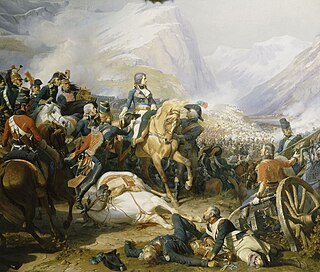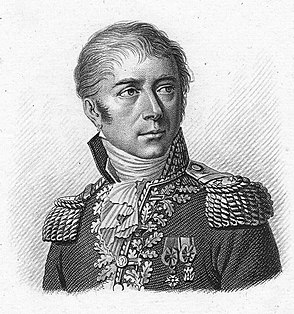
The Battle of Arcole or Battle of Arcola was a battle fought between French and Austrian forces 25 kilometres (16 mi) southeast of Verona during the War of the First Coalition, a part of the French Revolutionary Wars.

Jean-Mathieu-Philibert Sérurier, 1st Comte Sérurier led a division in the War of the First Coalition and became a Marshal of France under Emperor Napoleon. He was born into the minor nobility and in 1755 joined the Laon militia which was soon sent to fight in the Seven Years' War. After transferring into the regular army as an ensign, he was wounded at Warburg in 1760. He fought in the Spanish-Portuguese War in 1762. He married in 1779 after a promotion to captain. A newly minted major in 1789, the French Revolution sped up promotion so that he was colonel of the regiment in 1792. After leading Army of Italy troops in a number of actions, he became a general of brigade in 1793 and a general of division the following year.

The Battle of Castiglione saw the French Army of Italy under General Napoleon Bonaparte attack an army of Habsburg Austria led by Feldmarschall Dagobert Sigmund von Wurmser on 5 August 1796. The outnumbered Austrians were defeated and driven back along a line of hills to the river crossing at Borghetto, where they retired beyond the Mincio River. The town of Castiglione delle Stiviere is located 10 kilometres (6 mi) south of Lake Garda in northern Italy. This battle was one of four famous victories won by Bonaparte during the War of the First Coalition, part of the Wars of the French Revolution. The others were Bassano, Arcole, and Rivoli.

The Battle of Montebello was fought on 9 June 1800 near Montebello in Lombardy. During the lead-up to the Battle of Marengo, the vanguard of the French army in Italy engaged and defeated an Austrian force in a "glorious victory".
The Second Battle of Dego was fought on 14 and 15 April 1796 during the French Revolutionary Wars between French forces and Austro-Sardinian forces. The battle was fought near Dego, a hamlet in northwestern Italy, and ended in a French victory.

The Battle of Montenotte was fought on 12 April 1796, during the French Revolutionary Wars, between the French army under General Napoleon Bonaparte and an Austrian corps under Count Eugène-Guillaume Argenteau. The French won the battle, which was fought near the village of Cairo Montenotte in the Kingdom of Sardinia-Piedmont. The modern town is located in the northwestern part of Italy. On 11 April, Argenteau led 3,700 men in several assaults against a French mountaintop redoubt but failed to take it. By the morning of the 12th, Bonaparte concentrated large forces against Argenteau's now-outnumbered troops. The strongest French push came from the direction of the mountaintop redoubt, but a second force fell on the weak Austrian right flank and overwhelmed it. In its hasty retreat from the field, Argenteau's force lost heavily and was badly disorganized. This attack against the boundary between the Austrian and Sardinian armies threatened to sever the link between the two allies. This action was part of the Montenotte Campaign.
Giovanni Marchese di Provera, or Johann Provera, born c. 1736 – died 5 July 1804, served in the Austrian army in Italy during the French Revolutionary Wars. Provera played a significant role in three campaigns against General Napoleon Bonaparte during the Italian Campaign of 1796.

During the Siege of Mantua, which lasted from 4 July 1796 to 2 February 1797 with a short break, French forces under the overall command of Napoleon Bonaparte besieged and blockaded a large Austrian garrison at Mantua for many months until it surrendered. This eventual surrender, together with the heavy losses incurred during four unsuccessful relief attempts, led indirectly to the Austrians suing for peace in 1797. The siege occurred during the War of the First Coalition, which is part of the French Revolutionary Wars. Mantua, a city in the Lombardy region of Italy, lies on the Mincio River.
Adam Bajalics von Bajaháza, also Adam Bajalić von Bajaházy or Adam Bayalitsch, entered Austrian military service and fought against Prussia, Ottoman Turkey, and France. During the 1796–1797 Italian campaign against Napoleon Bonaparte, he commanded a brigade or a division in several actions.
In the Battle of Fleurus Jean-Baptiste Jourdan's French army repulsed an attack by the combined Austro-Dutch army led by Prince Josias of Saxe-Coburg-Saalfeld. Tactically the battle was a draw but strategically it was a decisive French victory. The battle led to the collapse of the Coalition position in the Austrian Netherlands.
In the Battle of Arcole on 15 to 17 November 1796, the French Army of Italy commanded by Napoleon Bonaparte won a victory over the army of Austria led by Jozsef Alvinczi. The battle was part the third relief of the Siege of Mantua in which Alvinczi's army repulsed Bonaparte at the Second Battle of Bassano on 6 November and at the Battle of Caldiero on 12 November. Meanwhile, Paul Davidovich's Austrian Tyrol Corps clashed with Claude Vaubois' French division at Cembra on 2 November. Davidovich defeated Vaubois at the Battle of Calliano on 6–7 November and Rivoli Veronese on 17 November. After Bonaparte's triumph at Arcola, he turned on the Tyrol Corps, beat it at Rivoli on 21 November, and forced it to retreat north into the mountains.

In the Montenotte campaign between 10 and 28 April 1796, General Napoleon Bonaparte's French Army of Italy broke the link between Feldzeugmeister Johann Peter Beaulieu's Austrian army and Feldmarschallleutnant Michelangelo Alessandro Colli-Marchi's Sardinian army. In subsequent engagements, the French defeated the Austrians, pursued Colli to the west, and forced the Sardinians to withdraw from the First Coalition against France. Actions were fought at Voltri on 10 April, Monte Negino (Legino) on 11 April, Montenotte on 12 April, Millesimo on 13 April, Dego on 14–15 April, Ceva on 16 April, San Michele Mondovi on 19 April, and Mondovì on 21 April.

The Montenotte campaign began on 10 April 1796 with an action at Voltri and ended with the Armistice of Cherasco on 28 April. In his first army command, Napoleon Bonaparte's French army separated the army of the Kingdom of Sardinia-Piedmont under Michelangelo Alessandro Colli-Marchi from the allied Austrian army led by Johann Peter Beaulieu. The French defeated both Austrian and Sardinian armies and forced Sardinia to quit the First Coalition. The campaign formed part of the Wars of the French Revolution. Montenotte Superiore is located at the junction of Strada Provinciale 12 and 41 in the Liguria region of northwest Italy, 15 kilometres (9 mi) northeast of Carcare municipality. However, the fighting occurred in an area from Genoa on the east to Cuneo on the west.
The Battle of Calliano on 6 and 7 November 1796 saw an Austrian corps commanded by Paul Davidovich rout a French division directed by Claude Belgrand de Vaubois. The engagement was part of the third Austrian attempt to relieve the French siege of Mantua during the French Revolutionary Wars. The battle was preceded by a clash at Cembra on 2 November and followed by actions at Rivoli Veronese on 17 and 21 November.
The Second Battle of Bassano on 6 November 1796, saw a Habsburg Austrian army commanded by Jozsef Alvinczi fight Napoleon Bonaparte's French Army of Italy. The Austrians repulsed persistent French attacks in a struggle in which both sides suffered heavy losses. The engagement, which happened two months after the more famous Battle of Bassano, marked the first tactical defeat of Bonaparte's career and occurred near Bassano del Grappa in Northern Italy during the French Revolutionary Wars. The action was part of the third relief of the Siege of Mantua during the War of the First Coalition.

The Battle of Verona was fought on 18 October 1805 between the French Army of Italy under the command of André Masséna and an Austrian army led by Archduke Charles, Duke of Teschen. By the end of the day, Massena seized a bridgehead on the east bank of the Adige River, driving back the defending troops under Josef Philipp Vukassovich. The action took place near the city of Verona in northern Italy during the War of the Third Coalition, part of the Napoleonic Wars.

The Battle of Neumarkt-Sankt Veit on 24 April 1809 saw a Franco-Bavarian force led by Marshal Jean-Baptiste Bessières face an Austrian Empire army commanded by Johann von Hiller. Hiller's numerically superior force won a victory over the Allied troops, forcing Bessières to retreat to the west. Neumarkt-Sankt Veit is located ten kilometers north of Mühldorf and 33 kilometers southeast of Landshut in Bavaria.

Pascal Antoine Fiorella or Pasquale Antonio, comte Fiorella became a French general officer in the French Revolutionary Wars and led a brigade during Napoleon Bonaparte's famous campaign in Italy in 1796. A Corsican by birth, he joined the French Royal Army as a volunteer in 1770 and was quickly appointed an officer. When the French Revolution broke out, he was a captain. Elected lieutenant colonel of a volunteer battalion, he fought with the Army of the Alps. Transferred to the Army of Italy, he assumed command of the 46th Line Infantry Demi-Brigade in February 1794. He fought under André Masséna at Saorgio where he was wounded. In September 1794 he earned promotion to general of brigade and led the army reserve.

The Battle of Messkirch on 5 May 1800 was the second major engagement of the Rhine Campaign of 1800. It followed the Battle of Stockach on 3 May. The campaign began on 25 April when a French force emerged from the Kehl bridgehead. This marked the start of the offensive of Jean Victor Marie Moreau's Army of the Rhine against Paul Kray's army of Habsburg Austria and its Bavarian, Württemberg and other German allies.




















